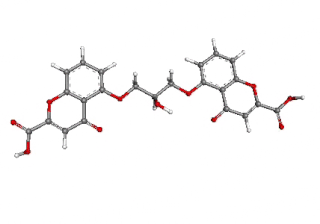H1 antagonists, also called H1 blockers, are a class of medications that block the action of histamine at the H1 receptor, helping to relieve allergic reactions. Agents where the main therapeutic effect is mediated by negative modulation of histamine receptors are termed antihistamines; other agents may have antihistaminergic action but are not true antihistamines.

Allergic rhinitis, of which the seasonal type is called hay fever, is a type of inflammation in the nose that occurs when the immune system overreacts to allergens in the air. Signs and symptoms include a runny or stuffy nose, sneezing, red, itchy, and watery eyes, and swelling around the eyes. The fluid from the nose is usually clear. Symptom onset is often within minutes following allergen exposure, and can affect sleep and the ability to work or study. Some people may develop symptoms only during specific times of the year, often as a result of pollen exposure. Many people with allergic rhinitis also have asthma, allergic conjunctivitis, or atopic dermatitis.

Loratadine, sold under the brand name Claritin among others, is a medication used to treat allergies. This includes allergic rhinitis and hives. It is also available in drug combinations such as loratadine/pseudoephedrine, in which it is combined with pseudoephedrine, a nasal decongestant. It is taken orally.

Cetirizine is a second-generation antihistamine used to treat allergic rhinitis, dermatitis, and urticaria (hives). It is taken by mouth. Effects generally begin within thirty minutes and last for about a day. The degree of benefit is similar to other antihistamines such as diphenhydramine, which is a first-generation antihistamine.

Fexofenadine, sold under the brand name Allegra among others, is an antihistamine pharmaceutical drug used in the treatment of allergy symptoms, such as hay fever and urticaria.

Nasal sprays are used to deliver medications locally in the nasal cavities or systemically. They are used locally for conditions such as nasal congestion and allergic rhinitis. In some situations, the nasal delivery route is preferred for systemic therapy because it provides an agreeable alternative to injection or pills. Substances can be assimilated extremely quickly and directly through the nose. Many pharmaceutical drugs exist as nasal sprays for systemic administration. Other applications include hormone replacement therapy, treatment of Alzheimer's disease and Parkinson's disease. Nasal sprays are seen as a more efficient way of transporting drugs with potential use in crossing the blood–brain barrier.

Cromoglicic acid (INN)—also referred to as cromolyn (USAN), cromoglycate, or cromoglicate—is traditionally described as a mast cell stabilizer, and is commonly marketed as the sodium salt sodium cromoglicate or cromolyn sodium. This drug prevents the release of inflammatory chemicals such as histamine from mast cells.

Allergic conjunctivitis (AC) is inflammation of the conjunctiva due to allergy. Although allergens differ among patients, the most common cause is hay fever. Symptoms consist of redness, edema (swelling) of the conjunctiva, itching, and increased lacrimation. If this is combined with rhinitis, the condition is termed allergic rhinoconjunctivitis (ARC).

Fluticasone propionate, sold under the brand names Flovent and Flonase among others, is a steroid medication. When inhaled it is used for the long term management of asthma and COPD. In the nose it is used for hay fever and nasal polyps. It can also be used for mouth ulcers. It works by decreasing inflammation.

Levocetirizine, sold under the brand name Xyzal, among others, is a second-generation antihistamine used for the treatment of allergic rhinitis and long-term hives of unclear cause. It is less sedating than older antihistamines. It is taken by mouth.

Ketotifen is an antihistamine medication and a mast cell stabilizer commonly used to treat allergic conditions such as conjunctivitis, asthma, and urticaria (hives). Ketotifen is available in ophthalmic and oral forms: the ophthalmic form relieves eye itchiness and irritation associated with seasonal allergies, while the oral form helps prevent systemic conditions such as asthma attacks and allergic reactions. In addition to treating allergies, ketotifen has shown efficacy in managing systemic mast cell diseases such as mastocytosis and mast cell activation syndrome (MCAS), which involve abnormal accumulation or activation of mast cells throughout the body. Ketotifen is also used for other allergic-type conditions like atopic dermatitis (eczema) and food allergies.

Nedocromil sodium is a medication considered as mast cell stabilizer which acts to prevent wheezing, shortness of breath, and other breathing problems caused by asthma. It is administered by an inhaler under the brand name Tilade, and as an eye drop under the brand name Alocril. The effects of nedocromil versus asthma are gradual rather than fast-acting and it is not indicated for acute respiratory distress compared to fast acting bronchodilators like albuterol or other well-known inhaler medications. Liquid preparations of nedocromil are available in the UK under the name Rapitil for use for allergic eye reactions. Nedocromil sodium has been shown to be effective in alleviating symptoms of allergic conjunctivitis.

Azelastine, sold under the brand name Optivar among others, is a H1 receptor-blocking medication primarily used as a nasal spray to treat allergic rhinitis (hay fever) and as eye drops for allergic conjunctivitis. Other uses may include asthma and skin rashes for which it is taken by mouth. Onset of effects is within minutes when used in the eyes and within an hour when used in the nose. Effects last for up to 12 hours.

Mast cell stabilizers are medications used to prevent or control certain allergic disorders. They block mast cell degranulation, stabilizing the cell and thereby preventing the release of histamine and related mediators. One suspected pharmacodynamic mechanism is the blocking of IgE-regulated calcium channels. Without intracellular calcium, the histamine vesicles cannot fuse to the cell membrane and degranulate.
Naphazoline/pheniramine, sold under the brand name Naphcon-A among others, is a combination eye drop used to help the symptoms of allergic conjunctivitis such as from hay fever. It contains naphazoline and pheniramine. It is used as an eye drop. Use is not recommended for more than three days.

Antazoline is a 1st generation antihistamine with anticholinergic properties used to relieve nasal congestion and in eye drops, usually in combination with naphazoline, to relieve the symptoms of allergic conjunctivitis. To treat allergic conjunctivitis, antazoline can be combined in a solution with tetryzoline. The drug is a Histamine H1 receptor antagonist: selectively binding to but not activating the receptor, thereby blocking the actions of endogenous histamine and subsequently leading to the temporary relief of the negative symptoms brought on by histamine.

Alcaftadine is used to prevent eye irritation brought on by allergic conjunctivitis. It is a H1 histamine receptor antagonist.

Bilastine is an antihistamine medication used to treat hives (urticaria), allergic rhinitis and itchy inflamed eyes (allergic conjunctivitis) caused by an allergy. It is a second-generation antihistamine and takes effect by selectively inhibiting the histamine H1 receptor, preventing these allergic reactions. Bilastine has an effectiveness similar to cetirizine, fexofenadine, and desloratadine.
Fexofenadine/pseudoephedrine, sold under the brand name Allegra-D among others, is a fixed-dose combination medication used for the treatment of nasal congestion and other symptoms of allergies and the common cold. It contains fexofenadine, as the hydrochloride, an antihistamine; and pseudoephedrine, as the hydrochloride, a nasal decongestant.
Cetirizine/pseudoephedrine (Zyrtec-D) is an antihistamine and decongestant formulation. It is a fixed-dose combination drug containing 5 mg cetirizine hydrochloride and 120 mg pseudoephedrine hydrochloride for symptoms related to seasonal allergic rhinitis. Cetirizine/pseudoephedrine gained approval from the U.S. Food and Drug Administration in 2001 as a prescription drug and became over-the-counter (OTC) in 2007.
















